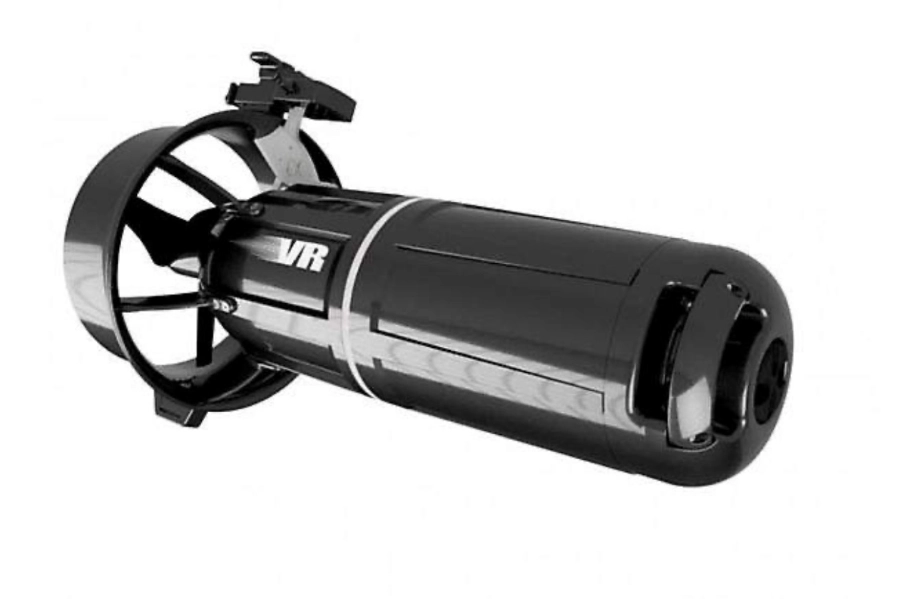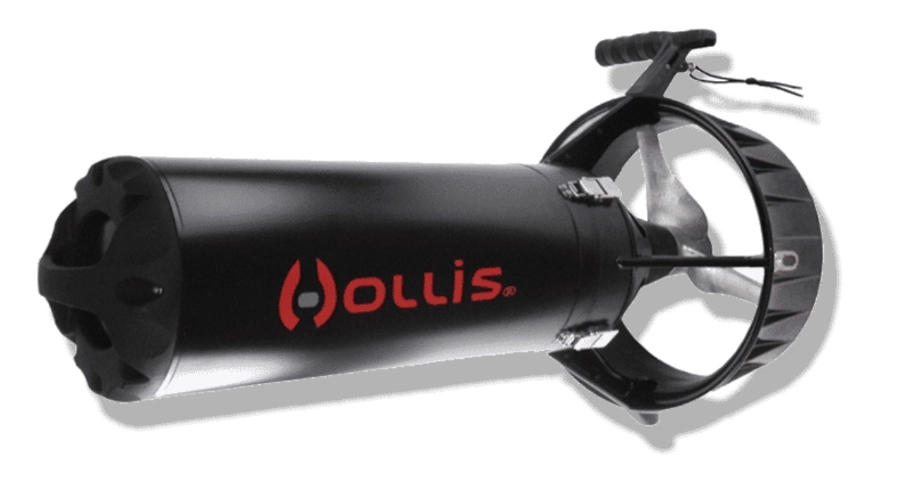Introduction to Dive Propulsion Vehicles
By the end of this lesson, you will be able to:
- Describe what a Dive Propulsion Vehicle is
- Describe the four types of DPV
- Explain the purpose and uses of Dive Propulsion Vehicles
In this section, we’ll look at what DPVs are and their basic components, serving as the foundation for the rest of the course.
Defining Dive Propulsion Vehicles
What is a Dive Propulsion Vehicle (DPV)?
A Dive Propulsion Vehicle (DPV), commonly known as an underwater scooter, is a device designed to enhance the mobility of scuba divers and freedivers significantly. It consists of a motorized propeller assembly that divers hold onto or attach to their bodies, allowing them to cover greater distances underwater with minimal physical exertion. DPVs are designed to operate in various aquatic environments, ranging from shallow coral reefs to deep underwater caves.
Key Components of a DPV
- Motor: The heart of a DPV, the motor is responsible for generating the thrust that propels the diver through the water. This motor is typically electric, powered by rechargeable batteries.
- Propeller: Attached to the motor, the propeller converts the motor’s rotational energy into thrust, moving the DPV forward. The design of the propeller, including its size and pitch, significantly influences the DPV’s speed and efficiency.
- Battery: The energy source for the motor. Batteries in modern DPVs are often lithium-based, offering a balance between weight, power output, and rechargeability. The battery life determines the DPV’s operational duration on a single charge.
- Buoyancy Control: This component is crucial for ensuring the DPV maintains neutral buoyancy underwater, making it easier to manoeuvre. Some DPVs have adjustable buoyancy systems to adapt to different diving conditions.
- Control Mechanisms: DPVs are equipped with controls allowing the diver to regulate speed and direction. These controls are designed to be simple and intuitive, often featuring a trigger or throttle mechanism.
- Safety Features: Modern DPVs come with various safety features, such as waterproofing for the electrical components, safety locks to prevent accidental activation, and automatic shutoff mechanisms in case the diver releases the DPV.
Types of DPVs
Recreational DPVs
These are typically smaller, lighter, and easier to handle, making them ideal for casual recreational diving. Designed for simplicity and ease of use, they often have limited speed and range compared to more advanced models.

Technical DPVs

Technical DPVs are robust, offer greater thrust, are built for more demanding diving environments and have extended battery life. They are designed to handle challenging conditions like strong currents, deeper dives, and longer-range explorations.
Professional and Commercial DPVs
These are the most powerful and durable models for heavy-duty use in commercial, scientific, and military applications. They often feature advanced navigation systems, extended battery life, and the ability to carry additional equipment.

Specialised DPVs

Tailored for specific purposes, these DPVs may have unique features like enhanced manoeuvrability, ultra-long battery life, or the ability to operate at extreme depths.
The Evolution of DPVs
Early 1960's
Birth of the Concept
The concept of underwater propulsion devices emerged, primarily for military use. These early models are rudimentary and largely experimental.
Mid 1970's
Commercial Introduction
The first commercially available DPVs enter the market. Initially designed for military and professional use, these devices are bulky and expensive.
Early 1980's
Recreational Adoption
DPVs begin to gain popularity in the recreational diving community. They are still relatively expensive and seen as a luxury item for divers.
Late 1980's
Affordability
Technological advancements lead to more compact and affordable DPVs, making them accessible to a broader range of divers.
Early 1990's
Battery Improvement
Significant improvements in battery technology enhance the range and reliability of DPVs.
Mid-1990's
Efficiency Improvements
DPVs become lighter and more efficient, with better buoyancy control and user-friendly features.
Early 2000's
Diversification and Specialisation
The market sees a diversification of DPV models, including those specifically designed for technical and cave diving.
Mid-2000's
Electric Motors
Introduction of eco-friendly DPVs with electric motors, emphasising environmental conservation.
Early 2010's
Integration of Modern Technology
Integration of advanced technology such as GPS, sonar navigation, and digital control systems in high-end DPV models.
Late 2010's
Customisation
DPVs become more customizable, with options for various attachments and accessories catering to specific diving needs.
2020's
Contemporary Developments
Ongoing advancements in battery efficiency, propulsion technology, and sustainable materials. Increasing focus on eco-friendly designs and enhanced safety features.
Importance of DPVs in Diving
DPVs have transformed the way divers explore the underwater world. They allow for longer dives by reducing physical fatigue and air consumption, provide access to distant or challenging dive sites, and can enhance the overall diving experience.
Purpose and Uses of Dive Propulsion Vehicles (DPVs)
Enhancing Dive Range
Dive Propulsion Vehicles enable divers to embark on extended explorations, covering significantly larger underwater areas. They provide access to remote dive sites that might otherwise be unreachable through swimming. This capability is particularly valuable in exploring vast reef systems or large shipwrecks, where the expanse of the area would be prohibitive to cover by swimming alone.
Conservation of Energy and Gas
DPVs significantly reduce the physical exertion required to move through water. This energy conservation is especially beneficial in conditions like strong currents or prolonged dives. Additionally, by minimising the effort, divers tend to consume gas more slowly, potentially extending the duration of their dives and allowing them to enjoy more time underwater.
Accessibility to Diverse Dive Sites
DPVs excel in providing accessibility to a variety of dive sites. They are superb for leisurely tours of shallow reefs, allowing divers to enjoy more of the reef without fatigue. In deep and technical diving, DPVs are pivotal in facilitating access to deeper sites managing the limited bottom time available at depth. They also play a critical role in enabling greater penetration into cave systems and wrecks, making previously unreachable areas accessible.
Supporting Scientific Research and Photography
In scientific contexts, DPVs are utilised for marine research, enabling scientists to cover large areas swiftly. This efficiency is crucial for surveying, sampling, and studying marine environments. DPVs are also a boon for underwater photographers and filmmakers, helping them keep pace with fast-moving subjects and navigate expansive underwater terrains, thereby capturing dynamic footage.
Search and Rescue Operations
In search and rescue operations, DPVs significantly increase the efficiency of search efforts. They enable faster coverage of large search areas, a critical factor in time-sensitive rescue situations.
Recreational Enjoyment
Apart from their practical applications, DPVs offer a unique and exhilarating experience, adding an element of fun and adventure to diving. This aspect of DPVs appeals to many underwater enthusiasts, enhancing the overall joy of diving.
The Mechanics of Dive Propulsion Vehicles
Let’s examine how these devices work by analysing their main components and operational principles. This knowledge is crucial for divers to understand the technological innovation behind DPVs and their usefulness in different diving situations.
Basic Operation
The fundamental operation of a Dive Propulsion Vehicle (DPV) revolves around its ability to provide motorized propulsion underwater. At its core, a DPV consists of an electric motor that drives a propeller. When activated, the motor spins the propeller, which in turn pushes water backwards, propelling the DPV and the diver forward. This simple yet effective mechanism allows divers to travel at greater speeds and with less effort compared to traditional swimming.
Design Variations
DPVs come in various designs, each tailored to specific diving needs. The size, shape, and power of the DPV depend on its intended use, ranging from small, handheld models for recreational diving to larger, more robust units for technical and professional applications. Some DPVs are designed to be neutrally buoyant for ease of manoeuvrability, while others might have adjustable buoyancy to suit different diving conditions.
Motor and Propulsion System
The motor is a critical component of a DPV, and its efficiency directly impacts its performance. Most DPVs use electric motors due to their reliability and ease of maintenance. The propulsion system, including the motor and propeller, determines the speed and thrust of the DPV. Advanced models may offer variable speed controls, allowing divers to adjust the pace according to their needs.
Battery and Power Supply
Modern DPVs typically use rechargeable batteries, with lithium-ion batteries being popular due to their high energy density and long life. The battery’s capacity dictates the DPV’s runtime and, by extension, the range a diver can cover on a single charge. Some high-end models may feature interchangeable batteries, enabling longer dives with quick battery swaps.
Control Mechanisms
Control mechanisms in DPVs are designed for ease of use, even with gloved hands. These typically include a trigger or throttle for speed control and may have safety locks to prevent accidental activation. Some advanced DPVs also feature electronic control systems, allowing for precise adjustments and even pre-set speed settings.
Safety Features
Safety is paramount in DPV design. Key safety features include waterproofing of electrical components, automatic shutoff systems in case the diver releases the DPV, and overheat protection for the motor. Some models also come equipped with depth alarms and battery life indicators to ensure divers can manage their dives safely.
Understanding the mechanics behind DPVs provides divers with a deeper appreciation of these sophisticated devices. It also underscores the importance of proper training and familiarization with the specific model of DPV being used, ensuring both the safety and enjoyment of the diving experience.
Before you go Diving
Before we get in the water, let’s make sure all the paperwork is sorted. It’s just a formality, but it’s important to have everything in order before we descend. Your dive instructor will likely go over these with you, so don’t hesitate to ask any questions you might have.

